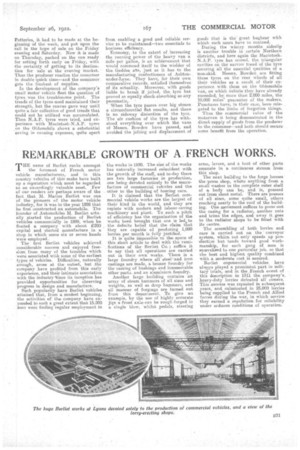REMARKABLE GROWTH OF A FRENCH WORKS.
Page 15

If you've noticed an error in this article please click here to report it so we can fix it.
THE name of Berliet ranks amongst the foremost of French motor vehicle manufacturers, and in this country vehicles of this make have built up a reputation which must be regarded as an exceedingly valuable asset. Few of our readers are perhaps aware of the fact that M. Marius Berliet was one of the pioneers of the motor vehicle industry, for it was in the year 1898 that he first constructed an automobile. The founder of Automobiles N. Berliet actually atarted the production of Berliet vehicles commercially in 1899, when he floated a company with about £200 capital and started manufacture in a shop in which some six or seven hands were employed.
The first Berliet vehicles achieved considerable success and enjoyed freedom: from many of the troubles which were aesociated with some of the earliest types of vehicles. Difficulties, naturally enough, arose at the outset, hut .the company have profited from this early experience, and their intimate association with the industry 'Since its inception has provided opportunities for observing progress in design and manufacture. Such popularity have Berliet vehicles attained that, from a modest beginning, the activities of thecompany have expanded to such a great extent that 15,000 men were finding regular employment in the works in 1920. The size of the works has naturally increased coincident with the growth of the staff, and to-day there are two large factories in production, one being devoted entirely to the maimfacture of commercial vehicles and the other to the building of touring cars. It is claimed that the Berliet, commercial vehicle works are the largest of their kind in the world, and they are replete with modern and labour-saving machinery and plant. To such a pitch of efficiency has the organization of the works been brought that one is led, to the definite belief that the claim triat they are capable of producing 1,000 lorries per month is fully justified. It is quite impossible in the space of this short article to deal with the 'ramifications of the Berliet Co. ; suffice it to say that all operations are carried out in their own works. There is a large foundry where all steel'and iron castings are made, abronze foundry for the casting of bushings and innumerable other parts. and an aluminium foundry. Another large building contains an array of steam hammers of all sizes and weights, as well as drop hammers, and all manner of f urgings are turned out from this department. To give an example, by the use of highly accurate jigs a front axlsacan be rough-forged in a single blow, 'whilst pedals, steering arms, levers, and a host of other parts emanate in a, continuous stream from this shop.
The next building to the forge houses the press shop, where anything from a small washer to the complete outer shell of a. body can be, anti is, pressed out from sheet metal. There are presses of all sizes, some quite small, others reaching nearly to the roof of the building. One movement suffices to press out the casing for a. radiator' another cuts and trims the edges, and away it, goes to the radiator shops to be fitted with its centre.
The assembling of both lorries and cars is carried out on the conveyor system, whiennot only' speeds up productian but tends toward good workmanship, for each gang of men is snecialiaed to one particular job, so that the best and highest quality combined with, a moderate cost is assured. Berliet commercial vehicles have alsysi,ys played a isrominent part in military trials, and in the French event of this description in 1911 the company's_ hoavy-duty lorries defeated all corners. This success was repeated in subsequent years, and, culminated in 25,000 lorries being supplied to tho French and Allied forces during the war, in which service they earned a reputation for reliability under arduous conditions of operation.




























